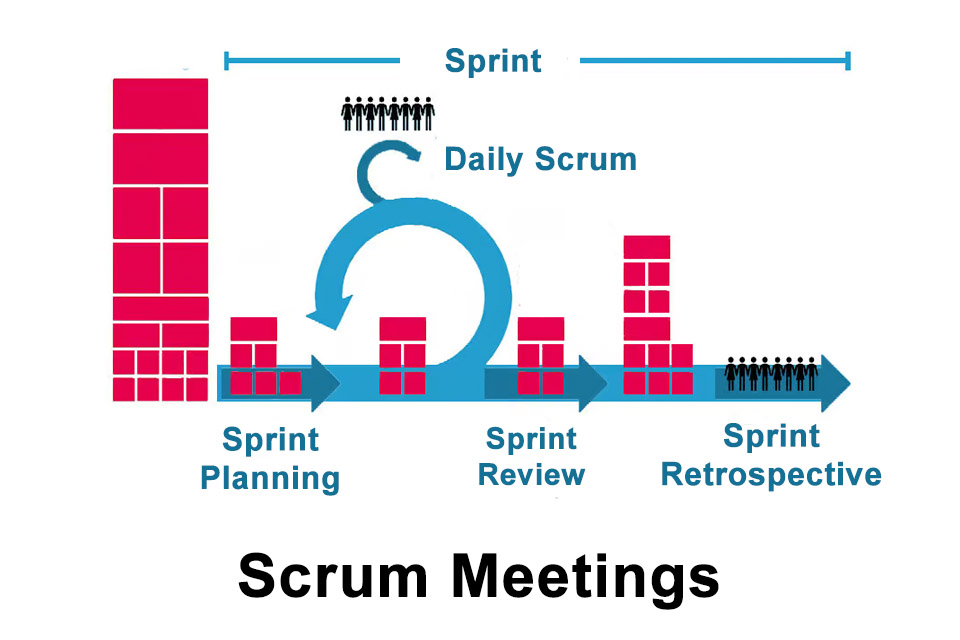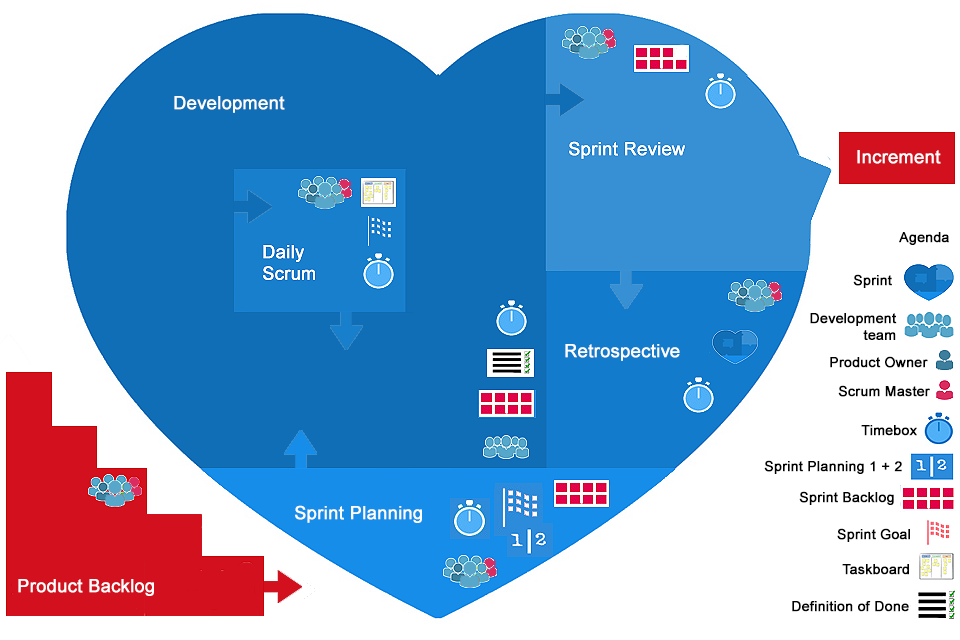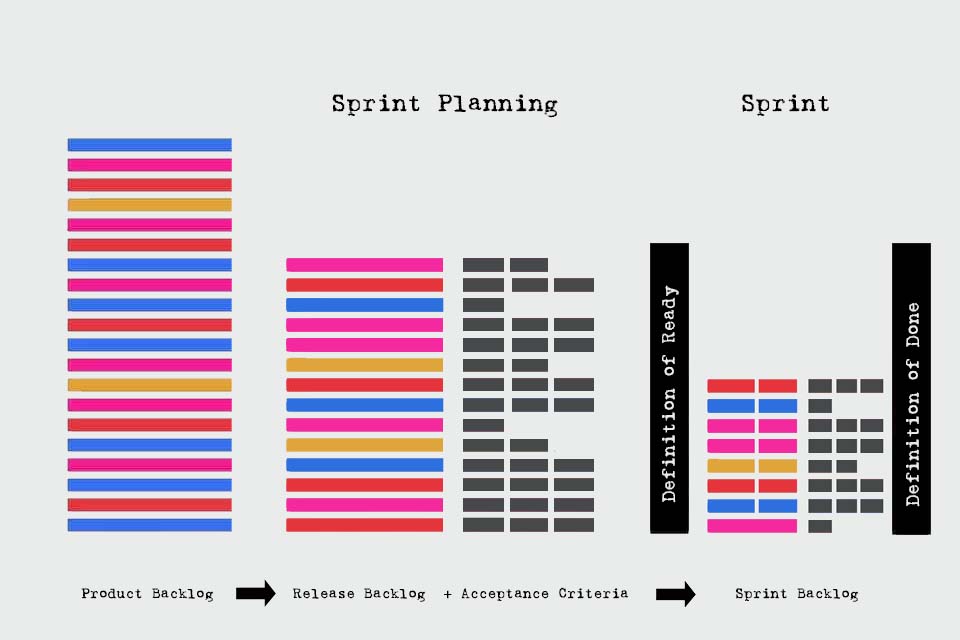What is a Scrum Meeting?
Smartpedia: In Scrum there are various meetings that take place regularly: Sprint Planning, Daily Scrum, Sprint Review, Retrospective and under certain circumstances the Scrum of Scrums.
Scrum Meetings – continuous exchange at eye level in Scrum
In Scrum there are a number of meetings that take place regularly between the parties involved in the development process. They are considered essential components of an agile approach to the development of software, products or services. Precisely because Scrum postulates cooperation with a corresponding mindset, it is important to exchange ideas continuously.
The Scrum Guide 2020 mentions the term meeting exactly twice:
- „Events are used in Scrum to create regularity and to minimize the need for meetings not defined in Scrum. Optimally, all events are held at the same time and place to reduce complexity.“
- „Daily Scrums improve communications, identify impediments, promote quick decision-making, and consequently eliminate the need for other meetings.“
Instead of meetings the Scrum Guide speaks of events. Events are meant “to minimize the need for additional meetings that are not defined in Scrum”. From this it follows at least indirectly: Events and meetings are synonyms.
But in practice there is one difference between event and meeting: the Sprint. The Scrum Guide speaks of “an event with a fixed length of one month or less in which all the work necessary to achieve the product goal takes place, including Sprint Planning, Daily Scrums, Sprint Review and Sprint Retrospective. Sprints are the heartbeat of Scrum”. The Sprint is therefore an event and not a meeting, the other events are also meetings.
The Scrum Meetings at a glance
Scrum knows the following meetings aka events besides the sprint:
- Sprint Planning
- Daily Scrum
- Sprint Review
- Sprint Retrospective
Sprint Planning serves to clarify the questions of “who” develops “what” in the current sprint and “how” the agreed backlog items are realised. The entire Scrum team (Scrum Master, Product Owner and Developer) takes part in Sprint Planning. Stakeholders could also be invited to the planning meeting, but they should be rather passive. Among other things, a Sprint Goal and the realisation of a potentially deliverable Increment must be agreed upon.
The Daily Scrum is a daily meeting where the developers can choose any structure and techniques as long as their exchange is focused on progress towards the Sprint Goal and a feasible plan for the next working day is created. According to the current Scrum Guide, this creates “focus and improves self-management”.
In practice, three questions have proved to be useful:
- What have I done since yesterday to reach the Sprint Goal?
- What will I do by tomorrow to reach the Sprint Goal?
- What is hindering me in my work?
Participation in the meeting is obligatory for the developers, in addition the Scrum Master should and could participate as well as the Product Owner. It is an exchange among equals, where it is not about blame, responsibility or the evaluation of the work of colleagues, but if necessary to agree on necessary adjustments to ensure the achievement of the Sprint Goal.
The Sprint Review is a meeting at the end of a Sprint to assess and approve the work done in relation to the set Sprint Goal. The Scrum Guide defines: “The purpose of the Sprint Review is to inspect the outcome of the Sprint and determine future adaptations. The Scrum Team presents the results of their work to key stakeholders and progress towards the product goal is discussed”.
Ideally, the team has completed each Sprint Backlog Item, but more importantly, the Sprint Goal agreed upon in the Sprint Planning is achieved. Only those items that have been completed according to the Definition of Done are presented in the Review.
A Sprint Retrospective a regular event where the Scrum Team meets to review the past Sprint and improve future teamwork. The Scrum Guide defines: “The Scrum Team inspects how the last Sprint went with regards to individuals, interactions, processes, tools, and their Definition of Done. The Scrum Team discusses what went well during the Sprint, what problems it encountered, and how those problems were (or were not) solved. The Scrum Team identifies the most helpful changes to improve its effectiveness”. In short, the Retrospective is a meeting to improve collaboration in detail and as a whole.
A special Scrum Meeting is the Scrum of Scrums. The Scrum Guide does not mention any scaling and thus neither Scrum of Scrums nor other procedures or frameworks. The Scrum of Scrums is relevant for many larger companies with several Scrum teams. It is a meeting of representatives of individual Scrum teams and serves the purpose of exchanging information about the status quo of the individual teams, about upcoming activities and possible obstacles in development.
The goal of the Scrum of Scrums is to synchronise the work of the different Scrum teams and to identify developments of teams that influence other teams in implementing their requirements.
Elements for successful Scrum Meetings
There are a number of elements that are essential for the successful conduct of Scrum Meetings:
- The Timebox defines the timeframe of each meeting.
- The frequency, start, location and schedule are fixed and maintained.
- The Definition of Ready, the Product Goal, the Sprint Goal and the Definition of Done help while working with Backlog Items.
- And the Vegas Rule ensures trusting interaction and exchange with each other.
It is precisely these elements that ensure that the Scrum Meetings as such are usually seen positively; in contrast to numerous meetings in classic projects or project organisations, which are often regarded as a waste of time.
Impulse to discuss
Scrum meetings are not an end in themselves, but must be coupled with the value proposition.
Notes:
The Backlog Refinement is also regularly included in developments that use Scrum as a framework. However, it is generally not seen as a Scrum Meeting or event, but rather as an ongoing task.
If you are interested in more explanations, we recommend the free Scrum Whitepaper.
If you like the article or would like to discuss it, please feel free to share it in your network. And if you have any comments, please do not hesitate to send us a message.
And here you will find additional information from our Smartpedia section:



